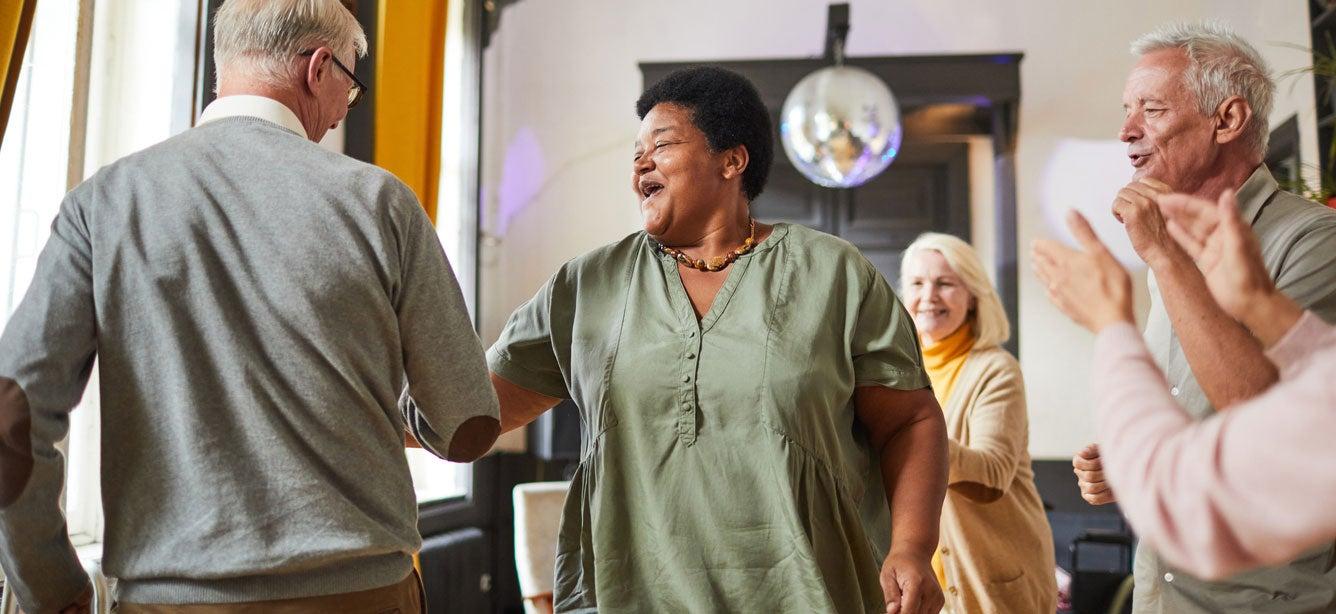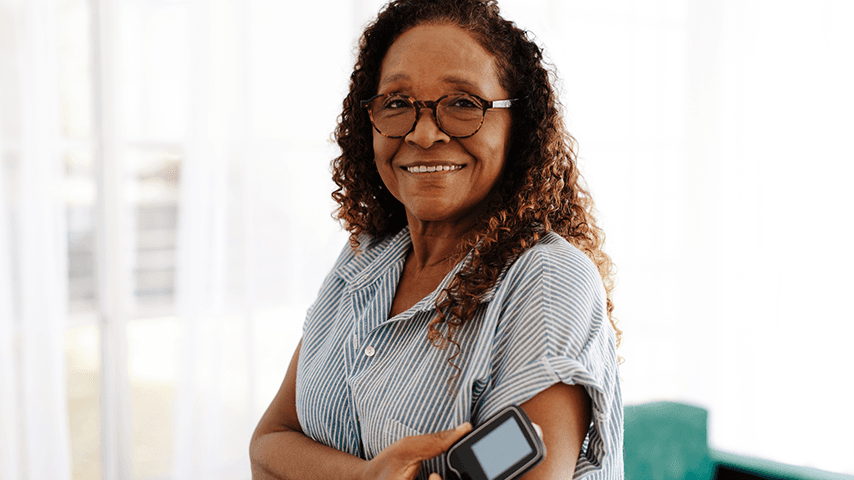
Related Topics
If you're living with diabetes, you may be wondering: Is exercise good for diabetes? The answer is a resounding yes! Regular physical activity offers many benefits for older adults with this chronic health condition.
What are the benefits of exercise for older adults with diabetes?
One important advantage of exercise is that it increases your sensitivity to insulin—a hormone that helps your cells convert blood glucose into energy. Being physically active while managing diabetes can help you:
- Control your blood sugar levels
- Keep your blood pressure in a healthy range
- Think and recall things more clearly
- Lower "bad" (LDL) cholesterol levels
- Lose weight or maintain a healthy weight
- Improve your balance and flexibility
- Sleep better
- Feel less stressed—and happier
- Reduce your risk of falling
One study found that exercise in older adults with diabetes increased the circulation of substances in the body that repair vascular and neuronal damage. This in turn may reduce the risk for heart disease and dementia—two common diabetes complications.1 Another study found that moderate- to high-intensity exercises helped older adults with type 2 diabetes not only control their blood sugar, but also improve their self-esteem, quality of life, and independence.2
What are the best exercises for older adults with diabetes?
A big part of sticking to any exercise regimen is choosing activities you enjoy. While there are many physical activities to choose from, below are six options that are easy, fun, and safe for most older adults.
- Walking: Walking is a simple, tried-and-true fitness staple. You can do it almost anywhere—in your neighborhood, at the track, on the beach, or in the city. Taking a stroll gets your blood flowing and your heart pumping. It also provides a built-in opportunity for sightseeing and socializing with your favorite people.
- Dancing: Got two left feet? Don't let that stop you from getting your groove on. Choreographed dancing stimulates your brain and can even improve memory. If you have limited mobility, chair dancing is a safe, enjoyable alternative.
And dancing just for fun is great, too, whether on your own or with a partner. You'll have a good time while improving your flexibility, easing anxiety, and burning calories.
- Yoga: The ancient practice of yoga aims to enhance strength, balance, and flexibility through gentle, fluid movements and stretches. It promotes mind-body connectedness and helps reduce stress and anxiety. In a systematic review of 16 studies, a daily habit of yoga or walking, along with an oral hypoglycemic agent, helped improve blood glucose levels.3 Chair yoga is a practical option for older adults with mobility challenges. The beauty of yoga is that it can be tailored to all age groups and fitness levels.
- Weight training: Resistance exercises and weight training help build lean muscle mass, something that's essential for older adults as well as people with type 2 diabetes. This is because losing muscle makes it more difficult to maintain stable glucose levels. Weight training doesn't necessarily mean lifting big, heavy weights. You can achieve results using machines, small free weights, and resistance bands.
How evidence-based falls prevention programs can improve fitness
There are several proven, evidence-based falls prevention programs designed to improve older adults’ fitness levels while also reducing the risk of falls.
- Tai Chi for Arthritis: This ancient form of exercise, which originates from China, has been shown to benefit many aspects of health. The Tai Chi for Arthritis and Fall Prevention program is especially beneficial for older adults. It features safe, gentle, and effective movements that can help you improve your balance, strength, flexibility, and even your immunity. Tai Chi for Arthritis also relieves stress, promotes relaxation, and gives you the opportunity to enrich your social connections.
- Stay Active & Independent for Life (SAIL): Designed for adults aged 65 and older, this community-based exercise program involves a fitness class that meets three times per week for one hour. You'll perform a mix of aerobic, balance, strength training, and stretching exercises that can be done in a seated or standing position, depending on your needs. SAIL encourages you to integrate movement into your daily life, helping you stay active and self-sufficient for longer.
- Enhance®Fitness (EF): This group exercise and falls prevention program was developed exclusively to support healthy aging. Like SAILS, EF meets three times a week for one hour. In each class, you'll focus on four key areas: low impact cardiovascular exercise, dynamic/static balance work, strength training with weights, and stretching. This is an opportunity to socialize with your peers while improving your balance, functional strength, and stamina.
- Swimming: Whether it's in the ocean, in your neighbor's pool, or at the local community center, swimming is an ideal low-impact activity for older adults with diabetes. It's easy on your joints, making it a good option for those with arthritis. Swimming also burns calories and increases relaxation. If you're swimming in public, always notify the lifeguard on duty that you have diabetes before you get into the water.
- Yardwork: Ok, maybe it's not your favorite pastime. But basic outdoor chores like mowing the lawn, pruning, weeding, and planting provide a healthy dose of exercise while shrinking your to-do list. In fact, just 30-45 minutes of working in the yard can torch up to 150 calories. When outside, be sure to wear sun protection (e.g., hat and sunscreen), take plenty of breaks, and stay hydrated.
If you like to exercise with other people—and make new friends—find your local area agency on aging and ask if they can recommend a location that offers any of these activities. Many senior centers offer a wide variety of programs, including those described above.
How many hours of exercise are recommended for people with diabetes?
According to the American Diabetes Association, people with diabetes should aim to get at least 150 minutes of moderate-intensity exercise each week. While that may seem like a daunting amount, you can break it up into smaller goals. For example, plan to exercise 30 minutes for 5 days, or 50 minutes three times a week. Try not to go more than 48 hours without exercising—this will help maximize the benefits on your blood glucose.
Always exercise safely. Before you start any exercise regimen, talk to your healthcare provider to make sure it's safe for you to proceed. Other tips for exercising when you have diabetes include:
- Prevent dehydration by drinking plenty of water before, during, and following physical activity.
- Learn how your body responds to activity by checking your blood sugar both before and after a workout.
- Wear identification stating you have diabetes. This will let others know in case of an emergency.
- If it's too cold outside—or too hot—exercise indoors or reschedule your workout.
- Wear cotton socks and well-fitting athletic shoes.
- After exercising, check your feet for cuts, sores, irritations, and other injuries. If they're not healing well within a couple of days, contact your doctor.
When it comes to exercising with diabetes, start small. Choose an easy activity, like walking your dog down the street, and gradually increase your time and intensity. If commitment is your main problem, put exercise on your weekly calendar and treat it like an important appointment (with yourself!). The more activity you engage in, the more habitual it will become—and the better you’ll feel.
Looking to learn more? Browse NCOA’s Diabetes for Older Adults resource library.
Sources
1. Boston University School of Public Health. Physical Activity Improves Cognitive and Vascular Health in Older People with Diabetes. Feb. 26, 2019. Found on the internet at https://www.bu.edu/sph/news/articles/2019/physical-activity-improves-cognitive-and-vascular-health-in-older-people-with-diabetes/
2. Eduardo Ferriolli, et al. Diabetes and exercise in the elderly. Medicine and Sports Science. 2014. Found on the internet at https://pubmed.ncbi.nlm.nih.gov/25226807/
3. Dhali B, et al. Effect of Yoga and Walking on Glycemic Control for the Management of Type 2 Diabetes: A Systematic Review and Meta-analysis. Journal of the ASEAN Federation of Endocrine Societies. 2023. Found on the internet at https://pubmed.ncbi.nlm.nih.gov/38045671/


